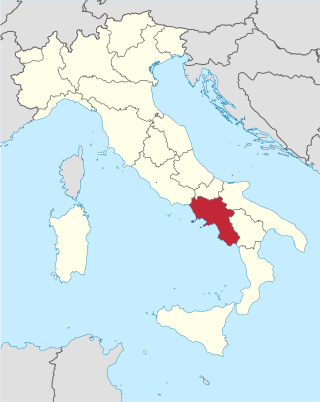
Campania is an administrative region of Italy located in Southern Italy; most of it is in the south-western portion of the Italian Peninsula, but it also includes the small Phlegraean Islands and the island of Capri. The capital of the Campania region is Naples. As of 2018, the region had a population of around 5,820,000 people, making it Italy's third most populous region, and, with an area of 13,590 km2 (5,247 sq mi), its most densely populated region. Based on its GDP, Campania is also the most economically productive region in Southern Italy and the 7th most productive in the whole country. Naples' urban area, which is in Campania, is the eighth most populous in the European Union. The region is home to 10 of the 58 UNESCO sites in Italy, including Pompeii and Herculaneum, the Royal Palace of Caserta, the Amalfi Coast, the Longobardian Church of Santa Sofia in Benevento and the Historic Centre of Naples. In addition, Campania's Mount Vesuvius is part of the UNESCO World Network of Biosphere Reserves.

Mount Vesuvius is a somma–stratovolcano located on the Gulf of Naples in Campania, Italy, about 9 km (5.6 mi) east of Naples and a short distance from the shore. It is one of several volcanoes forming the Campanian volcanic arc. Vesuvius consists of a large cone partially encircled by the steep rim of a summit caldera, resulting from the collapse of an earlier, much higher structure.
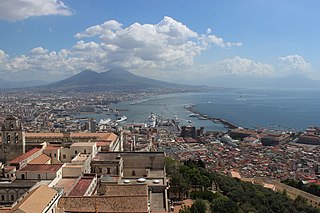
Naples is the regional capital of Campania and the third-largest city of Italy, after Rome and Milan, with a population of 909,048 within the city's administrative limits as of 2022. Its province-level municipality is the third-most populous metropolitan city in Italy with a population of 3,115,320 residents, and its metropolitan area stretches beyond the boundaries of the city wall for approximately 30 kilometres.

Januarius, also known as Januarius I of Benevento, was Bishop of Benevento and is a martyr and saint of the Catholic Church and the Eastern Orthodox Church. While no contemporary sources on his life are preserved, later sources and legends claim that he died during the Great Persecution, which ended with Diocletian's retirement in 305.

Cava de' Tirreni is a city and comune in the region of Campania, Italy, in the province of Salerno, 10 kilometres northwest of the town of Salerno. It lies in a richly cultivated valley surrounded by wooded hills, and is a popular tourist resort. The abbey of La Trinità della Cava is located there.

The Feast of San Gennaro, also known as San Gennaro Festival, is a Neapolitan and Italian-American patronal festival dedicated to Saint Januarius, patron saint of Naples and Little Italy, New York.

Altavilla Silentina is a town and comune located in the province of Salerno, Campania, some 100 km south of Naples, Italy.
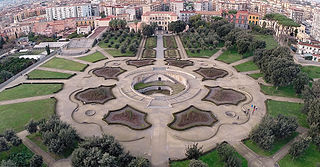
San Giorgio a Cremano is a primarily residential town and comune in the Metropolitan City of Naples, in Italy. It is located on the foothills of Mount Vesuvius to the west of the volcano and the sea, and is five kilometres to the south east of the centre of Naples. Most parts of the municipality command views of Mount Vesuvius, Mount Somma and the Bay of Naples.
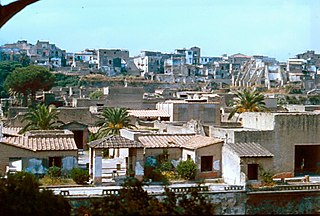
Ercolano is a town and comune in the Metropolitan City of Naples, Campania of Southern Italy. It lies at the western foot of Mount Vesuvius, on the Bay of Naples, just southeast of the city of Naples. The medieval town of Resina was built on the volcanic material left by the eruption of Vesuvius that destroyed the ancient city of Herculaneum, from which the present name is derived. Ercolano is a resort and the starting point for excursions to the excavations of Herculaneum and for the ascent of Vesuvius by bus. The town also manufactures leather goods, buttons, glass, and Lacryma Christi wine.

Angri is a town and comune in the province of Salerno, Campania, southern Italy. It is around 15 miles (24 km) northwest of the town of Salerno.
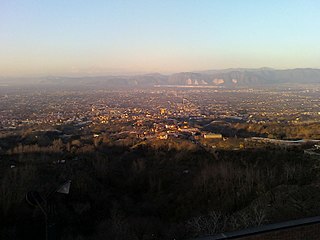
Somma Vesuviana is a town and comune in the Metropolitan City of Naples, Campania, southern Italy.
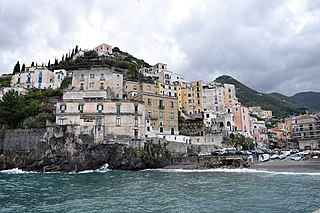
Minori is a comune in the province of Salerno, in the Campania region of south-western Italy. As a part of the Amalfi Coast, it was declared a UNESCO World Heritage Site in 1997.

Scafati is a comune (municipality) in the province of Salerno, in the Italian region of Campania.
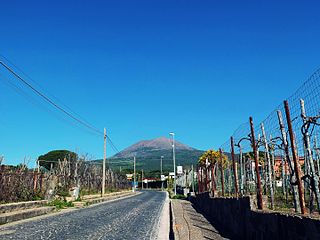
Boscotrecase is a town and municipality of 9,790 inhabitants in the metropolitan city of Naples in Campania, Italy.
Liveri is a comune (municipality) in the Metropolitan City of Naples in the Italian region Campania, located about 30 km northeast of Naples.

Ottaviano is a comune (municipality) in the Metropolitan City of Naples in the Italian region of Campania, located about 20 kilometres (12 mi) east of Naples and is located in the Vesuvian Area. Ottaviano was in Roman times a hamlet of houses within a vast estate belonging to the gens Octavia, Augustus' family.

Palma Campania, known until 1863 as Palma di Nola, is a comune (municipality) in the Metropolitan City of Naples in the Italian region Campania, located about 25 km east of Naples.

San Giuseppe Vesuviano is a comune (municipality) in the Metropolitan City of Naples in Italy, region Campania, located about 20 km east of Naples.

The Naples–Salerno high-speed railway line is a link in the Italian high-speed rail network opened in June 2008. The 29-kilometre-long (18 mi) line is one of the new high-speed lines being built to strengthen rail transport system in Italy and in particular freight and passenger transport in Campania. The line is part of Corridor 1 of the European Union's Trans-European high-speed rail network, which connects Berlin and Palermo.
The following is a timeline of the history of the city of Salerno in the Campania region of Italy.





















